Leadership Styles and Their Impact
VerifiedAdded on 2020/11/23
|16
|4996
|131
Discussion Board Post
AI Summary
This assignment delves into the diverse landscape of leadership styles, examining their distinct characteristics, strengths, and weaknesses. It analyzes the influence of these styles on follower behavior, job satisfaction, and overall organizational performance. Furthermore, it explores the crucial qualities that define effective leaders in contemporary contexts, emphasizing the importance of adaptability, communication, and ethical conduct.
Contribute Materials
Your contribution can guide someone’s learning journey. Share your
documents today.
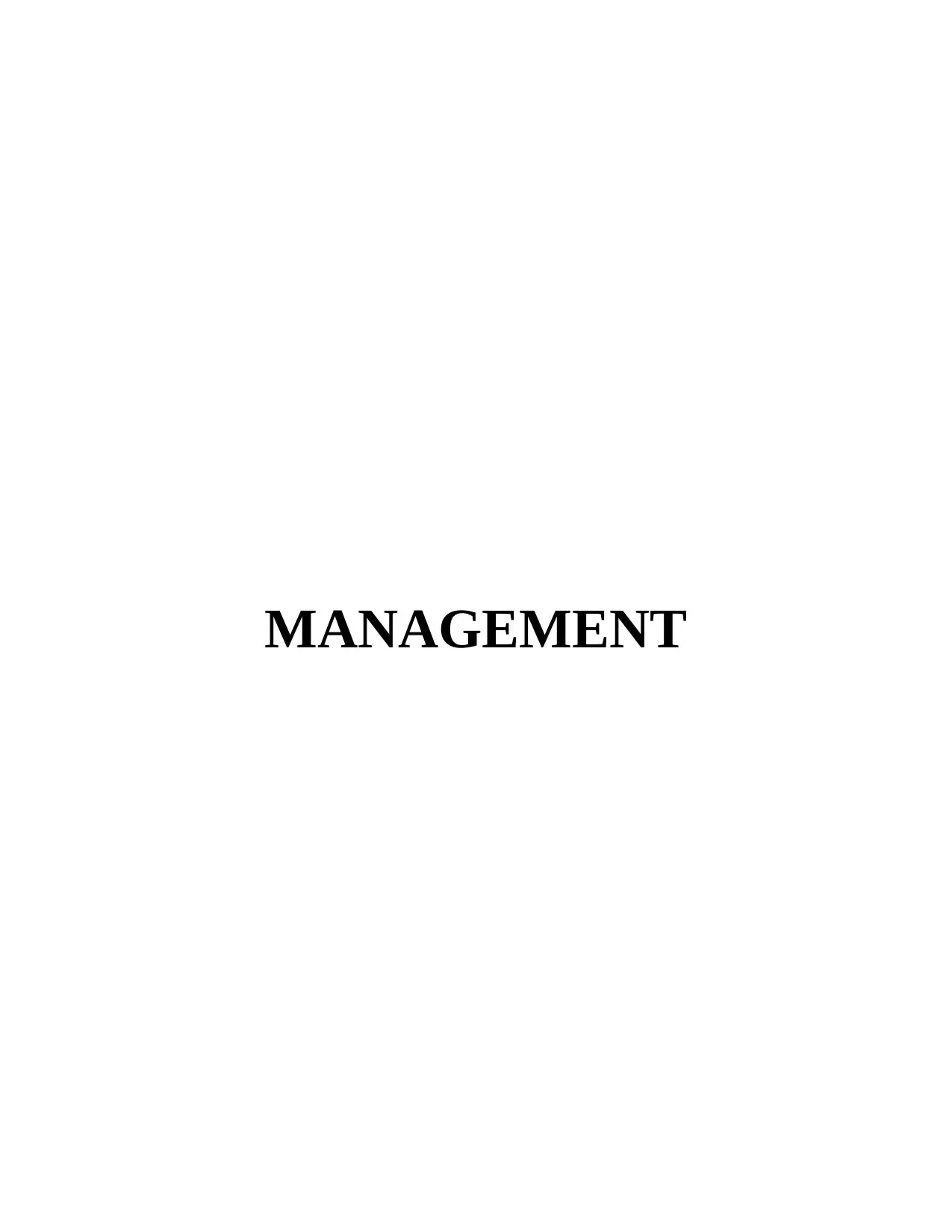
MANAGEMENT
Secure Best Marks with AI Grader
Need help grading? Try our AI Grader for instant feedback on your assignments.
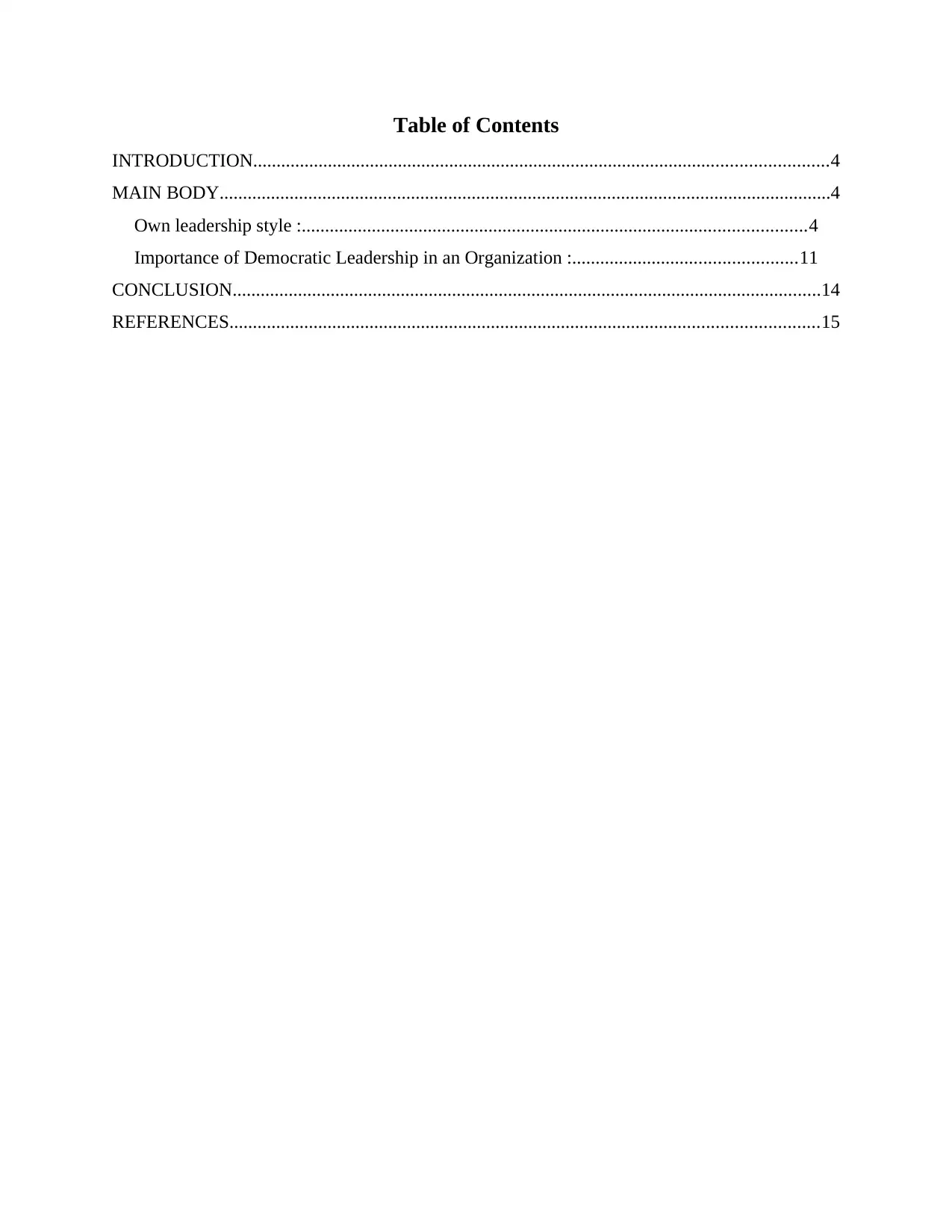
Table of Contents
INTRODUCTION...........................................................................................................................4
MAIN BODY...................................................................................................................................4
Own leadership style :............................................................................................................4
Importance of Democratic Leadership in an Organization :................................................11
CONCLUSION..............................................................................................................................14
REFERENCES..............................................................................................................................15
INTRODUCTION...........................................................................................................................4
MAIN BODY...................................................................................................................................4
Own leadership style :............................................................................................................4
Importance of Democratic Leadership in an Organization :................................................11
CONCLUSION..............................................................................................................................14
REFERENCES..............................................................................................................................15
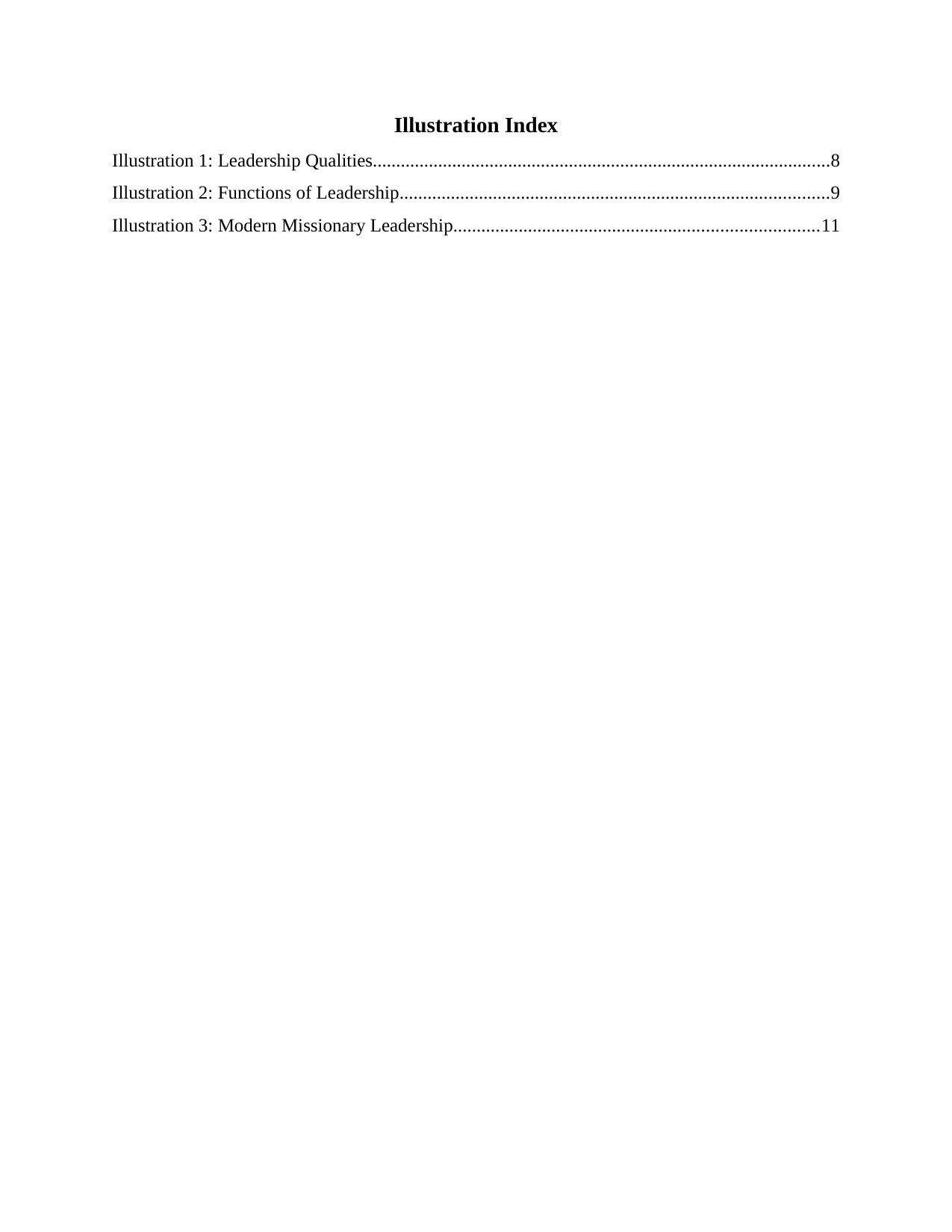
Illustration Index
Illustration 1: Leadership Qualities..................................................................................................8
Illustration 2: Functions of Leadership............................................................................................9
Illustration 3: Modern Missionary Leadership..............................................................................11
Illustration 1: Leadership Qualities..................................................................................................8
Illustration 2: Functions of Leadership............................................................................................9
Illustration 3: Modern Missionary Leadership..............................................................................11
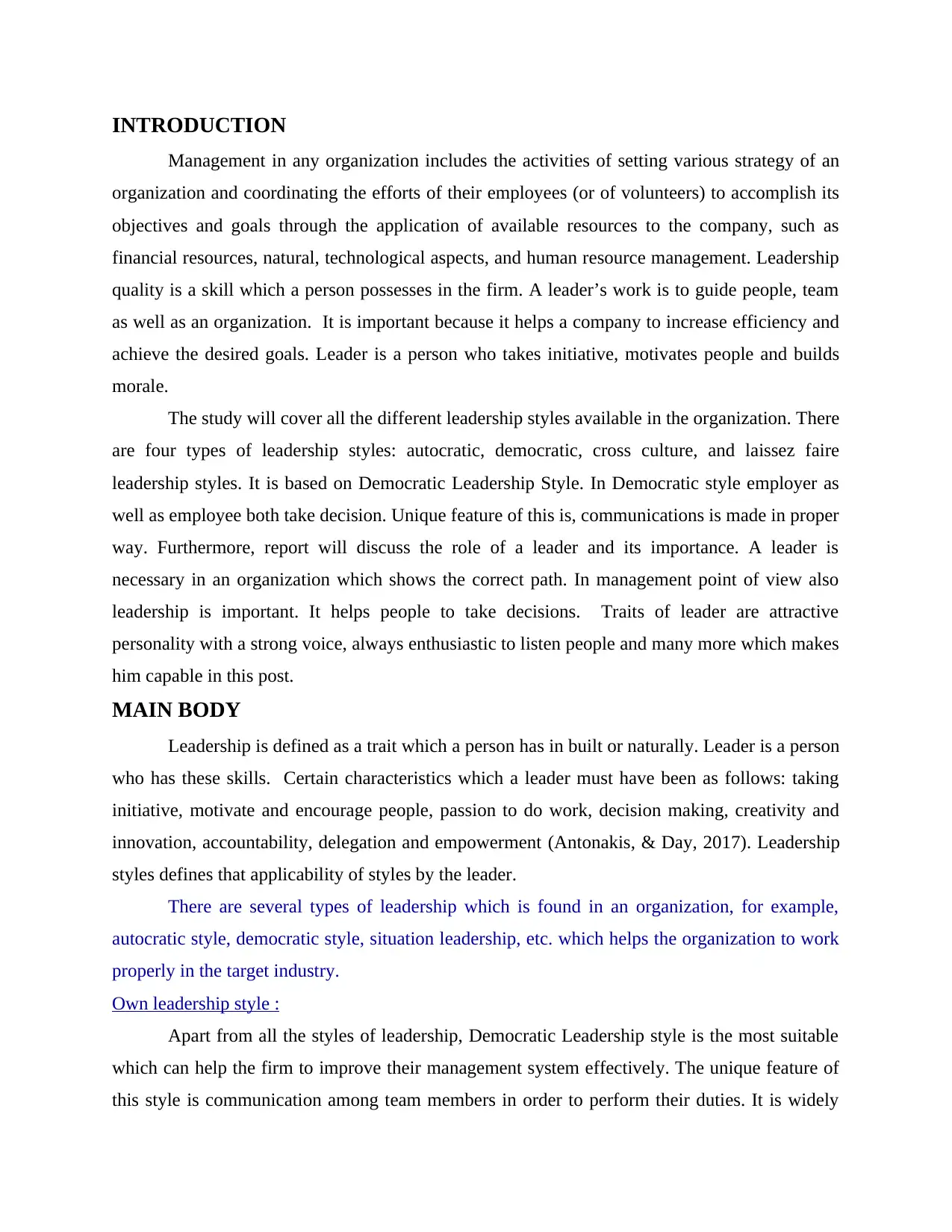
INTRODUCTION
Management in any organization includes the activities of setting various strategy of an
organization and coordinating the efforts of their employees (or of volunteers) to accomplish its
objectives and goals through the application of available resources to the company, such as
financial resources, natural, technological aspects, and human resource management. Leadership
quality is a skill which a person possesses in the firm. A leader’s work is to guide people, team
as well as an organization. It is important because it helps a company to increase efficiency and
achieve the desired goals. Leader is a person who takes initiative, motivates people and builds
morale.
The study will cover all the different leadership styles available in the organization. There
are four types of leadership styles: autocratic, democratic, cross culture, and laissez faire
leadership styles. It is based on Democratic Leadership Style. In Democratic style employer as
well as employee both take decision. Unique feature of this is, communications is made in proper
way. Furthermore, report will discuss the role of a leader and its importance. A leader is
necessary in an organization which shows the correct path. In management point of view also
leadership is important. It helps people to take decisions. Traits of leader are attractive
personality with a strong voice, always enthusiastic to listen people and many more which makes
him capable in this post.
MAIN BODY
Leadership is defined as a trait which a person has in built or naturally. Leader is a person
who has these skills. Certain characteristics which a leader must have been as follows: taking
initiative, motivate and encourage people, passion to do work, decision making, creativity and
innovation, accountability, delegation and empowerment (Antonakis, & Day, 2017). Leadership
styles defines that applicability of styles by the leader.
There are several types of leadership which is found in an organization, for example,
autocratic style, democratic style, situation leadership, etc. which helps the organization to work
properly in the target industry.
Own leadership style :
Apart from all the styles of leadership, Democratic Leadership style is the most suitable
which can help the firm to improve their management system effectively. The unique feature of
this style is communication among team members in order to perform their duties. It is widely
Management in any organization includes the activities of setting various strategy of an
organization and coordinating the efforts of their employees (or of volunteers) to accomplish its
objectives and goals through the application of available resources to the company, such as
financial resources, natural, technological aspects, and human resource management. Leadership
quality is a skill which a person possesses in the firm. A leader’s work is to guide people, team
as well as an organization. It is important because it helps a company to increase efficiency and
achieve the desired goals. Leader is a person who takes initiative, motivates people and builds
morale.
The study will cover all the different leadership styles available in the organization. There
are four types of leadership styles: autocratic, democratic, cross culture, and laissez faire
leadership styles. It is based on Democratic Leadership Style. In Democratic style employer as
well as employee both take decision. Unique feature of this is, communications is made in proper
way. Furthermore, report will discuss the role of a leader and its importance. A leader is
necessary in an organization which shows the correct path. In management point of view also
leadership is important. It helps people to take decisions. Traits of leader are attractive
personality with a strong voice, always enthusiastic to listen people and many more which makes
him capable in this post.
MAIN BODY
Leadership is defined as a trait which a person has in built or naturally. Leader is a person
who has these skills. Certain characteristics which a leader must have been as follows: taking
initiative, motivate and encourage people, passion to do work, decision making, creativity and
innovation, accountability, delegation and empowerment (Antonakis, & Day, 2017). Leadership
styles defines that applicability of styles by the leader.
There are several types of leadership which is found in an organization, for example,
autocratic style, democratic style, situation leadership, etc. which helps the organization to work
properly in the target industry.
Own leadership style :
Apart from all the styles of leadership, Democratic Leadership style is the most suitable
which can help the firm to improve their management system effectively. The unique feature of
this style is communication among team members in order to perform their duties. It is widely
Secure Best Marks with AI Grader
Need help grading? Try our AI Grader for instant feedback on your assignments.
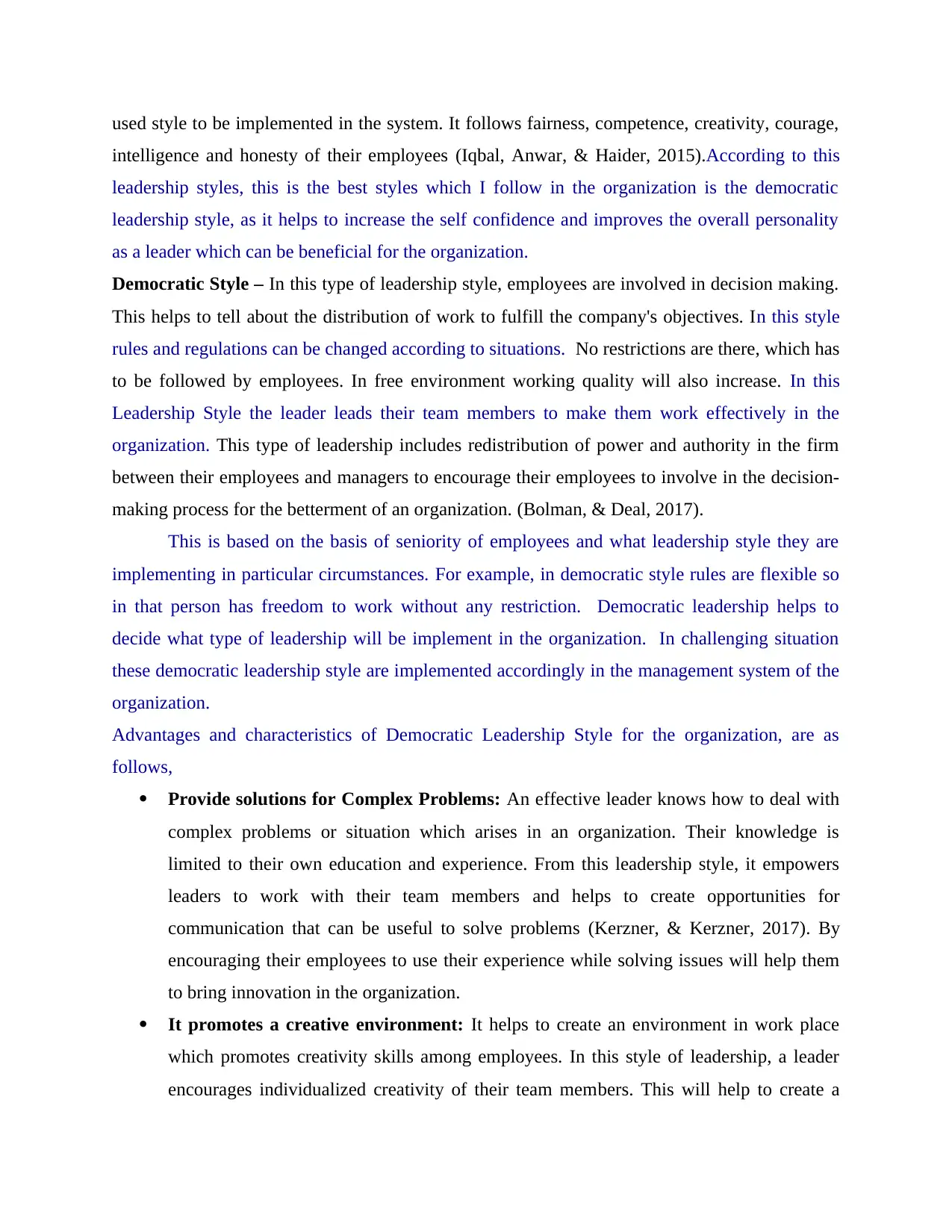
used style to be implemented in the system. It follows fairness, competence, creativity, courage,
intelligence and honesty of their employees (Iqbal, Anwar, & Haider, 2015).According to this
leadership styles, this is the best styles which I follow in the organization is the democratic
leadership style, as it helps to increase the self confidence and improves the overall personality
as a leader which can be beneficial for the organization.
Democratic Style – In this type of leadership style, employees are involved in decision making.
This helps to tell about the distribution of work to fulfill the company's objectives. In this style
rules and regulations can be changed according to situations. No restrictions are there, which has
to be followed by employees. In free environment working quality will also increase. In this
Leadership Style the leader leads their team members to make them work effectively in the
organization. This type of leadership includes redistribution of power and authority in the firm
between their employees and managers to encourage their employees to involve in the decision-
making process for the betterment of an organization. (Bolman, & Deal, 2017).
This is based on the basis of seniority of employees and what leadership style they are
implementing in particular circumstances. For example, in democratic style rules are flexible so
in that person has freedom to work without any restriction. Democratic leadership helps to
decide what type of leadership will be implement in the organization. In challenging situation
these democratic leadership style are implemented accordingly in the management system of the
organization.
Advantages and characteristics of Democratic Leadership Style for the organization, are as
follows,
Provide solutions for Complex Problems: An effective leader knows how to deal with
complex problems or situation which arises in an organization. Their knowledge is
limited to their own education and experience. From this leadership style, it empowers
leaders to work with their team members and helps to create opportunities for
communication that can be useful to solve problems (Kerzner, & Kerzner, 2017). By
encouraging their employees to use their experience while solving issues will help them
to bring innovation in the organization.
It promotes a creative environment: It helps to create an environment in work place
which promotes creativity skills among employees. In this style of leadership, a leader
encourages individualized creativity of their team members. This will help to create a
intelligence and honesty of their employees (Iqbal, Anwar, & Haider, 2015).According to this
leadership styles, this is the best styles which I follow in the organization is the democratic
leadership style, as it helps to increase the self confidence and improves the overall personality
as a leader which can be beneficial for the organization.
Democratic Style – In this type of leadership style, employees are involved in decision making.
This helps to tell about the distribution of work to fulfill the company's objectives. In this style
rules and regulations can be changed according to situations. No restrictions are there, which has
to be followed by employees. In free environment working quality will also increase. In this
Leadership Style the leader leads their team members to make them work effectively in the
organization. This type of leadership includes redistribution of power and authority in the firm
between their employees and managers to encourage their employees to involve in the decision-
making process for the betterment of an organization. (Bolman, & Deal, 2017).
This is based on the basis of seniority of employees and what leadership style they are
implementing in particular circumstances. For example, in democratic style rules are flexible so
in that person has freedom to work without any restriction. Democratic leadership helps to
decide what type of leadership will be implement in the organization. In challenging situation
these democratic leadership style are implemented accordingly in the management system of the
organization.
Advantages and characteristics of Democratic Leadership Style for the organization, are as
follows,
Provide solutions for Complex Problems: An effective leader knows how to deal with
complex problems or situation which arises in an organization. Their knowledge is
limited to their own education and experience. From this leadership style, it empowers
leaders to work with their team members and helps to create opportunities for
communication that can be useful to solve problems (Kerzner, & Kerzner, 2017). By
encouraging their employees to use their experience while solving issues will help them
to bring innovation in the organization.
It promotes a creative environment: It helps to create an environment in work place
which promotes creativity skills among employees. In this style of leadership, a leader
encourages individualized creativity of their team members. This will help to create a
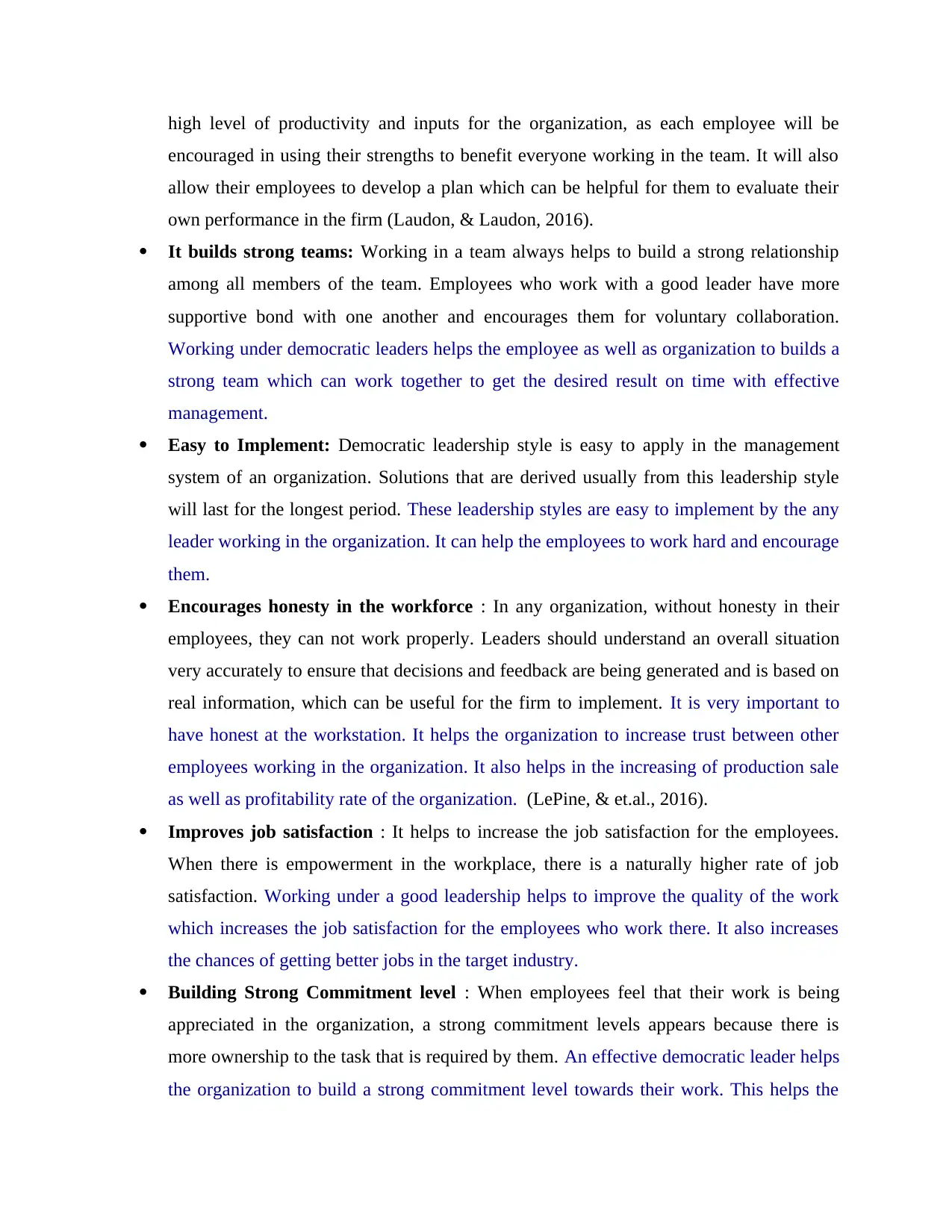
high level of productivity and inputs for the organization, as each employee will be
encouraged in using their strengths to benefit everyone working in the team. It will also
allow their employees to develop a plan which can be helpful for them to evaluate their
own performance in the firm (Laudon, & Laudon, 2016).
It builds strong teams: Working in a team always helps to build a strong relationship
among all members of the team. Employees who work with a good leader have more
supportive bond with one another and encourages them for voluntary collaboration.
Working under democratic leaders helps the employee as well as organization to builds a
strong team which can work together to get the desired result on time with effective
management.
Easy to Implement: Democratic leadership style is easy to apply in the management
system of an organization. Solutions that are derived usually from this leadership style
will last for the longest period. These leadership styles are easy to implement by the any
leader working in the organization. It can help the employees to work hard and encourage
them.
Encourages honesty in the workforce : In any organization, without honesty in their
employees, they can not work properly. Leaders should understand an overall situation
very accurately to ensure that decisions and feedback are being generated and is based on
real information, which can be useful for the firm to implement. It is very important to
have honest at the workstation. It helps the organization to increase trust between other
employees working in the organization. It also helps in the increasing of production sale
as well as profitability rate of the organization. (LePine, & et.al., 2016).
Improves job satisfaction : It helps to increase the job satisfaction for the employees.
When there is empowerment in the workplace, there is a naturally higher rate of job
satisfaction. Working under a good leadership helps to improve the quality of the work
which increases the job satisfaction for the employees who work there. It also increases
the chances of getting better jobs in the target industry.
Building Strong Commitment level : When employees feel that their work is being
appreciated in the organization, a strong commitment levels appears because there is
more ownership to the task that is required by them. An effective democratic leader helps
the organization to build a strong commitment level towards their work. This helps the
encouraged in using their strengths to benefit everyone working in the team. It will also
allow their employees to develop a plan which can be helpful for them to evaluate their
own performance in the firm (Laudon, & Laudon, 2016).
It builds strong teams: Working in a team always helps to build a strong relationship
among all members of the team. Employees who work with a good leader have more
supportive bond with one another and encourages them for voluntary collaboration.
Working under democratic leaders helps the employee as well as organization to builds a
strong team which can work together to get the desired result on time with effective
management.
Easy to Implement: Democratic leadership style is easy to apply in the management
system of an organization. Solutions that are derived usually from this leadership style
will last for the longest period. These leadership styles are easy to implement by the any
leader working in the organization. It can help the employees to work hard and encourage
them.
Encourages honesty in the workforce : In any organization, without honesty in their
employees, they can not work properly. Leaders should understand an overall situation
very accurately to ensure that decisions and feedback are being generated and is based on
real information, which can be useful for the firm to implement. It is very important to
have honest at the workstation. It helps the organization to increase trust between other
employees working in the organization. It also helps in the increasing of production sale
as well as profitability rate of the organization. (LePine, & et.al., 2016).
Improves job satisfaction : It helps to increase the job satisfaction for the employees.
When there is empowerment in the workplace, there is a naturally higher rate of job
satisfaction. Working under a good leadership helps to improve the quality of the work
which increases the job satisfaction for the employees who work there. It also increases
the chances of getting better jobs in the target industry.
Building Strong Commitment level : When employees feel that their work is being
appreciated in the organization, a strong commitment levels appears because there is
more ownership to the task that is required by them. An effective democratic leader helps
the organization to build a strong commitment level towards their work. This helps the

organization to increase their customer's rate in the market. It also helps to enhance their
products and services which they deliver to their clients.
Helps to create Vision for future : It helps to give a clear vision for the organization
which can be beneficial for the to plan their strategies according to that vision. This will
also ensure that firm is growing in the target market. For any organization it is very
important to have a clear aim and objective in the business as having a clear mission and
vision helps to achieve the target on time (McCleskey, 2014).
Increases Team Knowledge : Giving every employee a chance to contribute their
personal expertise and knowledge into the conversation, it can give everyone an
opportunity to expand their knowledge which can be useful for the organization. Working
in a team helps the organization to increase team knowledge which can be useful in
producing their products and services for their customers.
It is very important to have a good leader in the organization, because it can increase the sales
and production for the company which helps to generate a good revenue. Having an effective
leadership will be beneficial for the organization, for the following reasons,
The new generation working in the firm is more independent in nature and less
submissive and are not amenable to rigid control. It will help them to manage these
employees who are hard to control in the organization.
It will also help to communicate with different employees who generally looking for ego
satisfactions from their jobs, and
In any organization, it is very crucial to satisfy every employees working there. It will
help them to increase their production. As there are revolution of rising expectations
changed the attitude of the employees in the work place (McNeil, Frey, & Embrechts,
2015).
products and services which they deliver to their clients.
Helps to create Vision for future : It helps to give a clear vision for the organization
which can be beneficial for the to plan their strategies according to that vision. This will
also ensure that firm is growing in the target market. For any organization it is very
important to have a clear aim and objective in the business as having a clear mission and
vision helps to achieve the target on time (McCleskey, 2014).
Increases Team Knowledge : Giving every employee a chance to contribute their
personal expertise and knowledge into the conversation, it can give everyone an
opportunity to expand their knowledge which can be useful for the organization. Working
in a team helps the organization to increase team knowledge which can be useful in
producing their products and services for their customers.
It is very important to have a good leader in the organization, because it can increase the sales
and production for the company which helps to generate a good revenue. Having an effective
leadership will be beneficial for the organization, for the following reasons,
The new generation working in the firm is more independent in nature and less
submissive and are not amenable to rigid control. It will help them to manage these
employees who are hard to control in the organization.
It will also help to communicate with different employees who generally looking for ego
satisfactions from their jobs, and
In any organization, it is very crucial to satisfy every employees working there. It will
help them to increase their production. As there are revolution of rising expectations
changed the attitude of the employees in the work place (McNeil, Frey, & Embrechts,
2015).
Paraphrase This Document
Need a fresh take? Get an instant paraphrase of this document with our AI Paraphraser

Importance of a leader for the organization based on Democratic leadership style
Leaders have a huge role in any organization or business. It helps to maintain the
management properly. They are important to manage employees and making them capable to do
their work effectively. In business world, leaders and managers can use both these qualities i.e.
leadership and management principles, to build a strong team for the firm to work effectively in
an organization (Goodwin, & Wright, 2014). Leaders are those people who, build an inspiring
vision, and are innovators. There are so many various functions in the business world which a
leader performs in the organization, for example,
In the organization is very important to have a good leader as it helps to provide and
promote their vision and mission to their team members to accomplish it.
It will help them to give guidance which will direct their team members to manage their
work properly in the work place and complete it on time.
They try to recruit, eligible and strong candidates which can be effective for the
organization. They give them work to different team members according to their
qualities, abilities and personality.
Leaders can help to recruit high performers for their team employees working for them.
Illustration 1: Leadership Qualities
Source : (Managerial Leadership, 2014)
Leaders have a huge role in any organization or business. It helps to maintain the
management properly. They are important to manage employees and making them capable to do
their work effectively. In business world, leaders and managers can use both these qualities i.e.
leadership and management principles, to build a strong team for the firm to work effectively in
an organization (Goodwin, & Wright, 2014). Leaders are those people who, build an inspiring
vision, and are innovators. There are so many various functions in the business world which a
leader performs in the organization, for example,
In the organization is very important to have a good leader as it helps to provide and
promote their vision and mission to their team members to accomplish it.
It will help them to give guidance which will direct their team members to manage their
work properly in the work place and complete it on time.
They try to recruit, eligible and strong candidates which can be effective for the
organization. They give them work to different team members according to their
qualities, abilities and personality.
Leaders can help to recruit high performers for their team employees working for them.
Illustration 1: Leadership Qualities
Source : (Managerial Leadership, 2014)
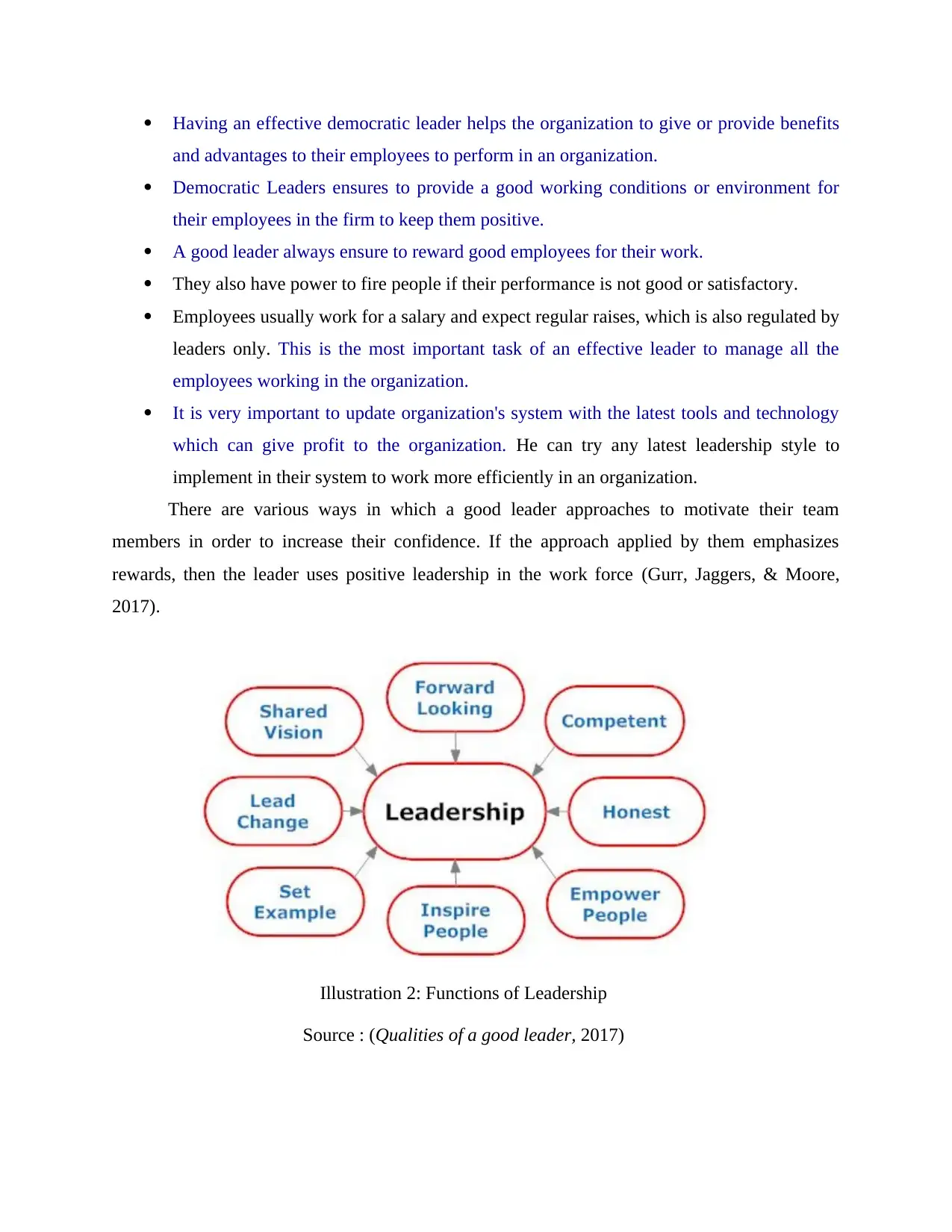
Having an effective democratic leader helps the organization to give or provide benefits
and advantages to their employees to perform in an organization.
Democratic Leaders ensures to provide a good working conditions or environment for
their employees in the firm to keep them positive.
A good leader always ensure to reward good employees for their work.
They also have power to fire people if their performance is not good or satisfactory.
Employees usually work for a salary and expect regular raises, which is also regulated by
leaders only. This is the most important task of an effective leader to manage all the
employees working in the organization.
It is very important to update organization's system with the latest tools and technology
which can give profit to the organization. He can try any latest leadership style to
implement in their system to work more efficiently in an organization.
There are various ways in which a good leader approaches to motivate their team
members in order to increase their confidence. If the approach applied by them emphasizes
rewards, then the leader uses positive leadership in the work force (Gurr, Jaggers, & Moore,
2017).
Illustration 2: Functions of Leadership
Source : (Qualities of a good leader, 2017)
and advantages to their employees to perform in an organization.
Democratic Leaders ensures to provide a good working conditions or environment for
their employees in the firm to keep them positive.
A good leader always ensure to reward good employees for their work.
They also have power to fire people if their performance is not good or satisfactory.
Employees usually work for a salary and expect regular raises, which is also regulated by
leaders only. This is the most important task of an effective leader to manage all the
employees working in the organization.
It is very important to update organization's system with the latest tools and technology
which can give profit to the organization. He can try any latest leadership style to
implement in their system to work more efficiently in an organization.
There are various ways in which a good leader approaches to motivate their team
members in order to increase their confidence. If the approach applied by them emphasizes
rewards, then the leader uses positive leadership in the work force (Gurr, Jaggers, & Moore,
2017).
Illustration 2: Functions of Leadership
Source : (Qualities of a good leader, 2017)
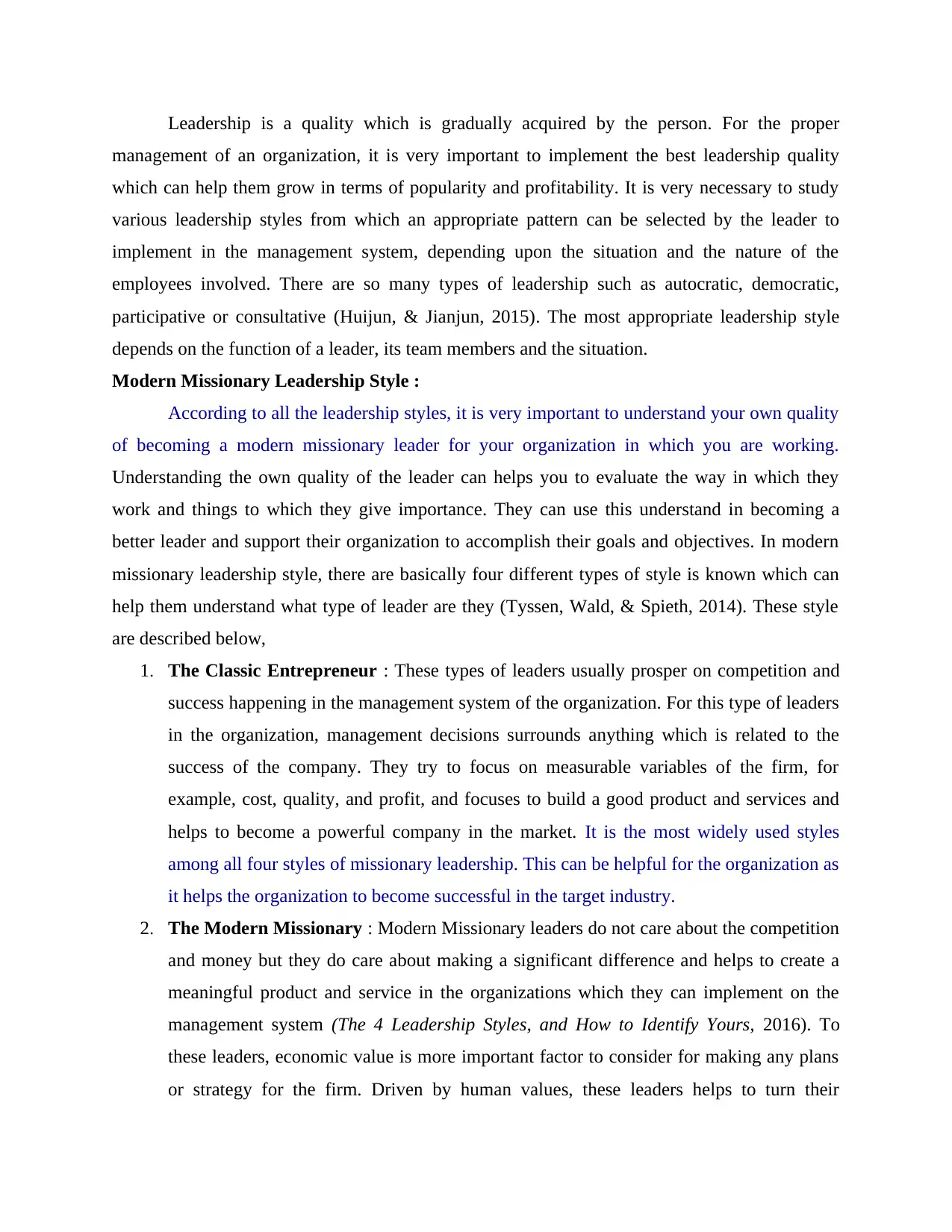
Leadership is a quality which is gradually acquired by the person. For the proper
management of an organization, it is very important to implement the best leadership quality
which can help them grow in terms of popularity and profitability. It is very necessary to study
various leadership styles from which an appropriate pattern can be selected by the leader to
implement in the management system, depending upon the situation and the nature of the
employees involved. There are so many types of leadership such as autocratic, democratic,
participative or consultative (Huijun, & Jianjun, 2015). The most appropriate leadership style
depends on the function of a leader, its team members and the situation.
Modern Missionary Leadership Style :
According to all the leadership styles, it is very important to understand your own quality
of becoming a modern missionary leader for your organization in which you are working.
Understanding the own quality of the leader can helps you to evaluate the way in which they
work and things to which they give importance. They can use this understand in becoming a
better leader and support their organization to accomplish their goals and objectives. In modern
missionary leadership style, there are basically four different types of style is known which can
help them understand what type of leader are they (Tyssen, Wald, & Spieth, 2014). These style
are described below,
1. The Classic Entrepreneur : These types of leaders usually prosper on competition and
success happening in the management system of the organization. For this type of leaders
in the organization, management decisions surrounds anything which is related to the
success of the company. They try to focus on measurable variables of the firm, for
example, cost, quality, and profit, and focuses to build a good product and services and
helps to become a powerful company in the market. It is the most widely used styles
among all four styles of missionary leadership. This can be helpful for the organization as
it helps the organization to become successful in the target industry.
2. The Modern Missionary : Modern Missionary leaders do not care about the competition
and money but they do care about making a significant difference and helps to create a
meaningful product and service in the organizations which they can implement on the
management system (The 4 Leadership Styles, and How to Identify Yours, 2016). To
these leaders, economic value is more important factor to consider for making any plans
or strategy for the firm. Driven by human values, these leaders helps to turn their
management of an organization, it is very important to implement the best leadership quality
which can help them grow in terms of popularity and profitability. It is very necessary to study
various leadership styles from which an appropriate pattern can be selected by the leader to
implement in the management system, depending upon the situation and the nature of the
employees involved. There are so many types of leadership such as autocratic, democratic,
participative or consultative (Huijun, & Jianjun, 2015). The most appropriate leadership style
depends on the function of a leader, its team members and the situation.
Modern Missionary Leadership Style :
According to all the leadership styles, it is very important to understand your own quality
of becoming a modern missionary leader for your organization in which you are working.
Understanding the own quality of the leader can helps you to evaluate the way in which they
work and things to which they give importance. They can use this understand in becoming a
better leader and support their organization to accomplish their goals and objectives. In modern
missionary leadership style, there are basically four different types of style is known which can
help them understand what type of leader are they (Tyssen, Wald, & Spieth, 2014). These style
are described below,
1. The Classic Entrepreneur : These types of leaders usually prosper on competition and
success happening in the management system of the organization. For this type of leaders
in the organization, management decisions surrounds anything which is related to the
success of the company. They try to focus on measurable variables of the firm, for
example, cost, quality, and profit, and focuses to build a good product and services and
helps to become a powerful company in the market. It is the most widely used styles
among all four styles of missionary leadership. This can be helpful for the organization as
it helps the organization to become successful in the target industry.
2. The Modern Missionary : Modern Missionary leaders do not care about the competition
and money but they do care about making a significant difference and helps to create a
meaningful product and service in the organizations which they can implement on the
management system (The 4 Leadership Styles, and How to Identify Yours, 2016). To
these leaders, economic value is more important factor to consider for making any plans
or strategy for the firm. Driven by human values, these leaders helps to turn their
Secure Best Marks with AI Grader
Need help grading? Try our AI Grader for instant feedback on your assignments.
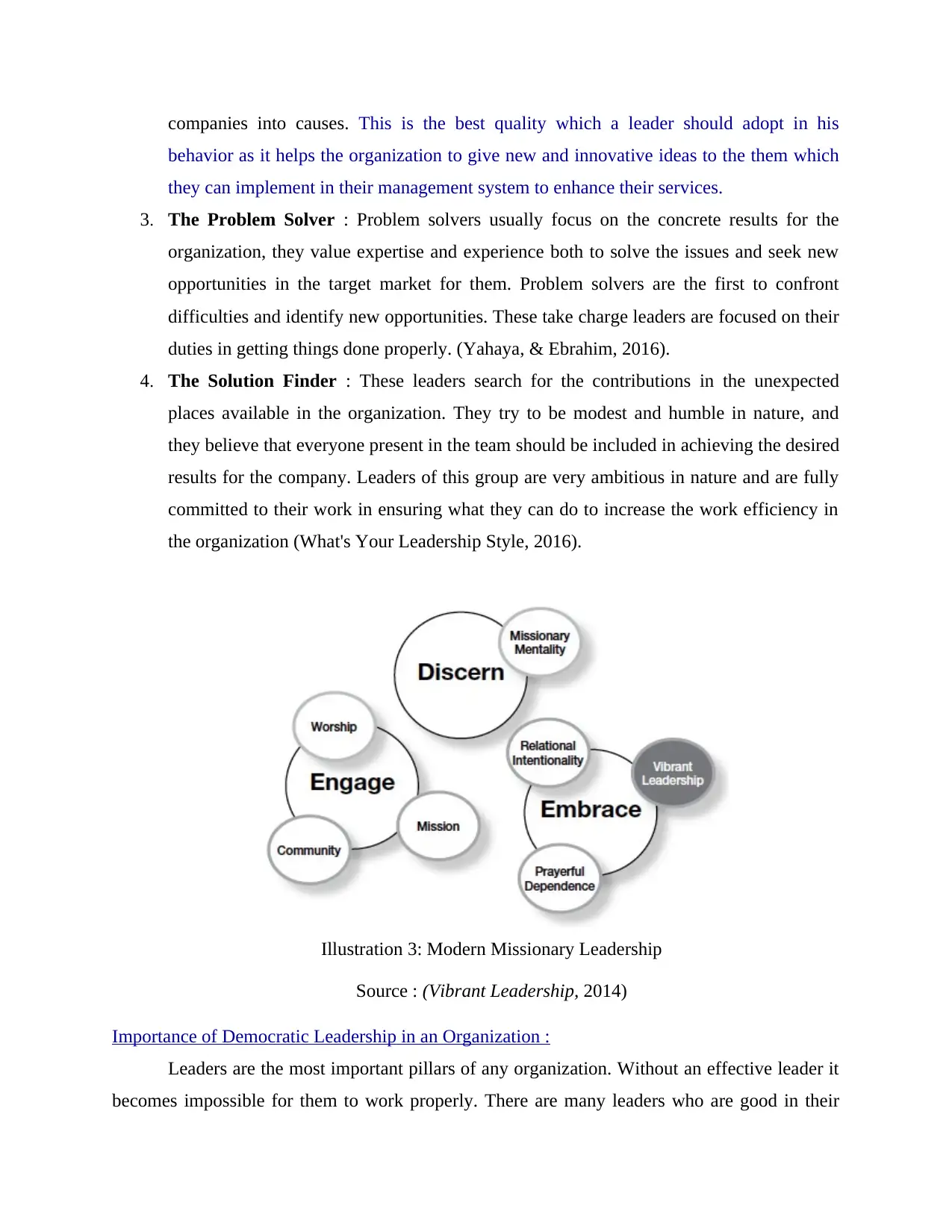
companies into causes. This is the best quality which a leader should adopt in his
behavior as it helps the organization to give new and innovative ideas to the them which
they can implement in their management system to enhance their services.
3. The Problem Solver : Problem solvers usually focus on the concrete results for the
organization, they value expertise and experience both to solve the issues and seek new
opportunities in the target market for them. Problem solvers are the first to confront
difficulties and identify new opportunities. These take charge leaders are focused on their
duties in getting things done properly. (Yahaya, & Ebrahim, 2016).
4. The Solution Finder : These leaders search for the contributions in the unexpected
places available in the organization. They try to be modest and humble in nature, and
they believe that everyone present in the team should be included in achieving the desired
results for the company. Leaders of this group are very ambitious in nature and are fully
committed to their work in ensuring what they can do to increase the work efficiency in
the organization (What's Your Leadership Style, 2016).
Importance of Democratic Leadership in an Organization :
Leaders are the most important pillars of any organization. Without an effective leader it
becomes impossible for them to work properly. There are many leaders who are good in their
Illustration 3: Modern Missionary Leadership
Source : (Vibrant Leadership, 2014)
behavior as it helps the organization to give new and innovative ideas to the them which
they can implement in their management system to enhance their services.
3. The Problem Solver : Problem solvers usually focus on the concrete results for the
organization, they value expertise and experience both to solve the issues and seek new
opportunities in the target market for them. Problem solvers are the first to confront
difficulties and identify new opportunities. These take charge leaders are focused on their
duties in getting things done properly. (Yahaya, & Ebrahim, 2016).
4. The Solution Finder : These leaders search for the contributions in the unexpected
places available in the organization. They try to be modest and humble in nature, and
they believe that everyone present in the team should be included in achieving the desired
results for the company. Leaders of this group are very ambitious in nature and are fully
committed to their work in ensuring what they can do to increase the work efficiency in
the organization (What's Your Leadership Style, 2016).
Importance of Democratic Leadership in an Organization :
Leaders are the most important pillars of any organization. Without an effective leader it
becomes impossible for them to work properly. There are many leaders who are good in their
Illustration 3: Modern Missionary Leadership
Source : (Vibrant Leadership, 2014)
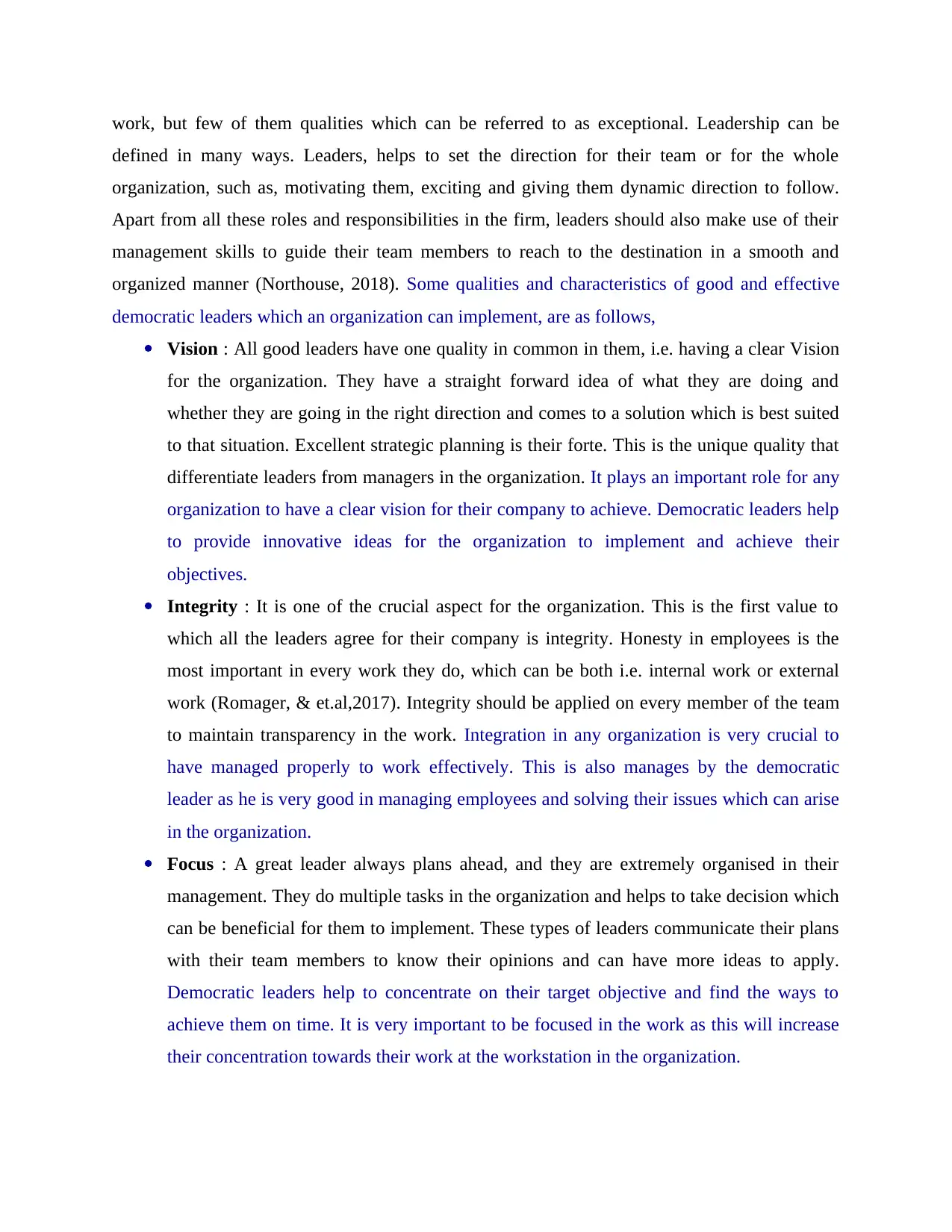
work, but few of them qualities which can be referred to as exceptional. Leadership can be
defined in many ways. Leaders, helps to set the direction for their team or for the whole
organization, such as, motivating them, exciting and giving them dynamic direction to follow.
Apart from all these roles and responsibilities in the firm, leaders should also make use of their
management skills to guide their team members to reach to the destination in a smooth and
organized manner (Northouse, 2018). Some qualities and characteristics of good and effective
democratic leaders which an organization can implement, are as follows,
Vision : All good leaders have one quality in common in them, i.e. having a clear Vision
for the organization. They have a straight forward idea of what they are doing and
whether they are going in the right direction and comes to a solution which is best suited
to that situation. Excellent strategic planning is their forte. This is the unique quality that
differentiate leaders from managers in the organization. It plays an important role for any
organization to have a clear vision for their company to achieve. Democratic leaders help
to provide innovative ideas for the organization to implement and achieve their
objectives.
Integrity : It is one of the crucial aspect for the organization. This is the first value to
which all the leaders agree for their company is integrity. Honesty in employees is the
most important in every work they do, which can be both i.e. internal work or external
work (Romager, & et.al,2017). Integrity should be applied on every member of the team
to maintain transparency in the work. Integration in any organization is very crucial to
have managed properly to work effectively. This is also manages by the democratic
leader as he is very good in managing employees and solving their issues which can arise
in the organization.
Focus : A great leader always plans ahead, and they are extremely organised in their
management. They do multiple tasks in the organization and helps to take decision which
can be beneficial for them to implement. These types of leaders communicate their plans
with their team members to know their opinions and can have more ideas to apply.
Democratic leaders help to concentrate on their target objective and find the ways to
achieve them on time. It is very important to be focused in the work as this will increase
their concentration towards their work at the workstation in the organization.
defined in many ways. Leaders, helps to set the direction for their team or for the whole
organization, such as, motivating them, exciting and giving them dynamic direction to follow.
Apart from all these roles and responsibilities in the firm, leaders should also make use of their
management skills to guide their team members to reach to the destination in a smooth and
organized manner (Northouse, 2018). Some qualities and characteristics of good and effective
democratic leaders which an organization can implement, are as follows,
Vision : All good leaders have one quality in common in them, i.e. having a clear Vision
for the organization. They have a straight forward idea of what they are doing and
whether they are going in the right direction and comes to a solution which is best suited
to that situation. Excellent strategic planning is their forte. This is the unique quality that
differentiate leaders from managers in the organization. It plays an important role for any
organization to have a clear vision for their company to achieve. Democratic leaders help
to provide innovative ideas for the organization to implement and achieve their
objectives.
Integrity : It is one of the crucial aspect for the organization. This is the first value to
which all the leaders agree for their company is integrity. Honesty in employees is the
most important in every work they do, which can be both i.e. internal work or external
work (Romager, & et.al,2017). Integrity should be applied on every member of the team
to maintain transparency in the work. Integration in any organization is very crucial to
have managed properly to work effectively. This is also manages by the democratic
leader as he is very good in managing employees and solving their issues which can arise
in the organization.
Focus : A great leader always plans ahead, and they are extremely organised in their
management. They do multiple tasks in the organization and helps to take decision which
can be beneficial for them to implement. These types of leaders communicate their plans
with their team members to know their opinions and can have more ideas to apply.
Democratic leaders help to concentrate on their target objective and find the ways to
achieve them on time. It is very important to be focused in the work as this will increase
their concentration towards their work at the workstation in the organization.
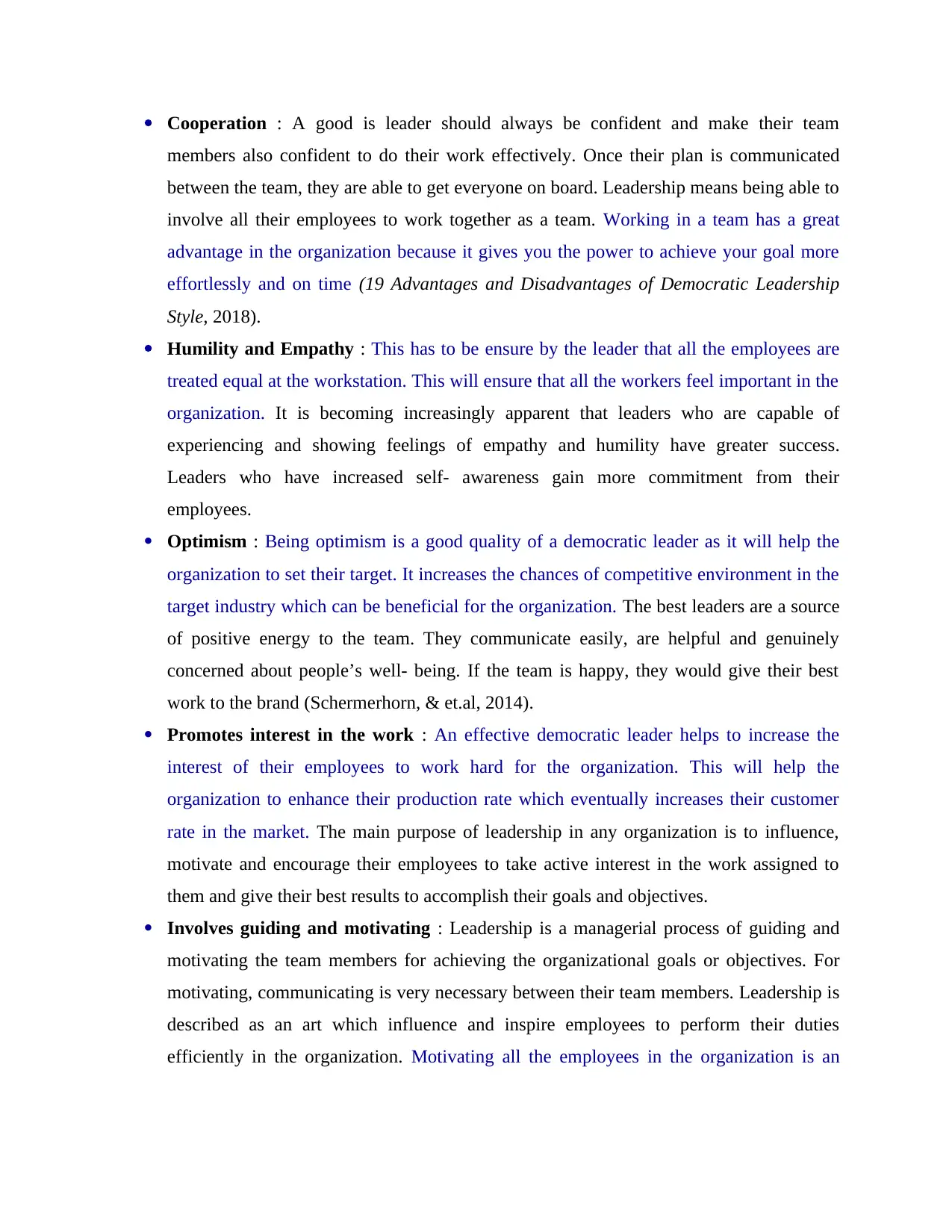
Cooperation : A good is leader should always be confident and make their team
members also confident to do their work effectively. Once their plan is communicated
between the team, they are able to get everyone on board. Leadership means being able to
involve all their employees to work together as a team. Working in a team has a great
advantage in the organization because it gives you the power to achieve your goal more
effortlessly and on time (19 Advantages and Disadvantages of Democratic Leadership
Style, 2018).
Humility and Empathy : This has to be ensure by the leader that all the employees are
treated equal at the workstation. This will ensure that all the workers feel important in the
organization. It is becoming increasingly apparent that leaders who are capable of
experiencing and showing feelings of empathy and humility have greater success.
Leaders who have increased self- awareness gain more commitment from their
employees.
Optimism : Being optimism is a good quality of a democratic leader as it will help the
organization to set their target. It increases the chances of competitive environment in the
target industry which can be beneficial for the organization. The best leaders are a source
of positive energy to the team. They communicate easily, are helpful and genuinely
concerned about people’s well- being. If the team is happy, they would give their best
work to the brand (Schermerhorn, & et.al, 2014).
Promotes interest in the work : An effective democratic leader helps to increase the
interest of their employees to work hard for the organization. This will help the
organization to enhance their production rate which eventually increases their customer
rate in the market. The main purpose of leadership in any organization is to influence,
motivate and encourage their employees to take active interest in the work assigned to
them and give their best results to accomplish their goals and objectives.
Involves guiding and motivating : Leadership is a managerial process of guiding and
motivating the team members for achieving the organizational goals or objectives. For
motivating, communicating is very necessary between their team members. Leadership is
described as an art which influence and inspire employees to perform their duties
efficiently in the organization. Motivating all the employees in the organization is an
members also confident to do their work effectively. Once their plan is communicated
between the team, they are able to get everyone on board. Leadership means being able to
involve all their employees to work together as a team. Working in a team has a great
advantage in the organization because it gives you the power to achieve your goal more
effortlessly and on time (19 Advantages and Disadvantages of Democratic Leadership
Style, 2018).
Humility and Empathy : This has to be ensure by the leader that all the employees are
treated equal at the workstation. This will ensure that all the workers feel important in the
organization. It is becoming increasingly apparent that leaders who are capable of
experiencing and showing feelings of empathy and humility have greater success.
Leaders who have increased self- awareness gain more commitment from their
employees.
Optimism : Being optimism is a good quality of a democratic leader as it will help the
organization to set their target. It increases the chances of competitive environment in the
target industry which can be beneficial for the organization. The best leaders are a source
of positive energy to the team. They communicate easily, are helpful and genuinely
concerned about people’s well- being. If the team is happy, they would give their best
work to the brand (Schermerhorn, & et.al, 2014).
Promotes interest in the work : An effective democratic leader helps to increase the
interest of their employees to work hard for the organization. This will help the
organization to enhance their production rate which eventually increases their customer
rate in the market. The main purpose of leadership in any organization is to influence,
motivate and encourage their employees to take active interest in the work assigned to
them and give their best results to accomplish their goals and objectives.
Involves guiding and motivating : Leadership is a managerial process of guiding and
motivating the team members for achieving the organizational goals or objectives. For
motivating, communicating is very necessary between their team members. Leadership is
described as an art which influence and inspire employees to perform their duties
efficiently in the organization. Motivating all the employees in the organization is an
Paraphrase This Document
Need a fresh take? Get an instant paraphrase of this document with our AI Paraphraser
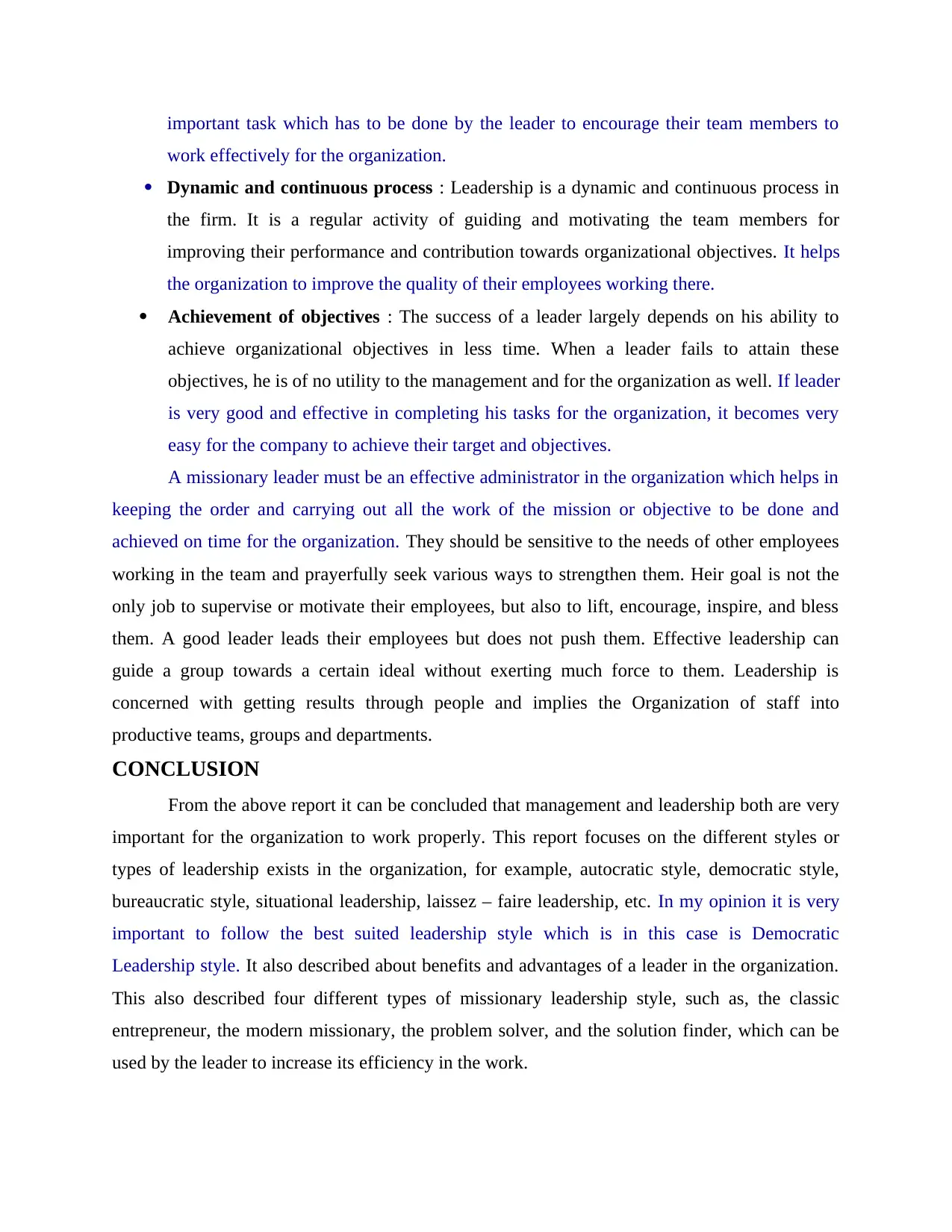
important task which has to be done by the leader to encourage their team members to
work effectively for the organization.
Dynamic and continuous process : Leadership is a dynamic and continuous process in
the firm. It is a regular activity of guiding and motivating the team members for
improving their performance and contribution towards organizational objectives. It helps
the organization to improve the quality of their employees working there.
Achievement of objectives : The success of a leader largely depends on his ability to
achieve organizational objectives in less time. When a leader fails to attain these
objectives, he is of no utility to the management and for the organization as well. If leader
is very good and effective in completing his tasks for the organization, it becomes very
easy for the company to achieve their target and objectives.
A missionary leader must be an effective administrator in the organization which helps in
keeping the order and carrying out all the work of the mission or objective to be done and
achieved on time for the organization. They should be sensitive to the needs of other employees
working in the team and prayerfully seek various ways to strengthen them. Heir goal is not the
only job to supervise or motivate their employees, but also to lift, encourage, inspire, and bless
them. A good leader leads their employees but does not push them. Effective leadership can
guide a group towards a certain ideal without exerting much force to them. Leadership is
concerned with getting results through people and implies the Organization of staff into
productive teams, groups and departments.
CONCLUSION
From the above report it can be concluded that management and leadership both are very
important for the organization to work properly. This report focuses on the different styles or
types of leadership exists in the organization, for example, autocratic style, democratic style,
bureaucratic style, situational leadership, laissez – faire leadership, etc. In my opinion it is very
important to follow the best suited leadership style which is in this case is Democratic
Leadership style. It also described about benefits and advantages of a leader in the organization.
This also described four different types of missionary leadership style, such as, the classic
entrepreneur, the modern missionary, the problem solver, and the solution finder, which can be
used by the leader to increase its efficiency in the work.
work effectively for the organization.
Dynamic and continuous process : Leadership is a dynamic and continuous process in
the firm. It is a regular activity of guiding and motivating the team members for
improving their performance and contribution towards organizational objectives. It helps
the organization to improve the quality of their employees working there.
Achievement of objectives : The success of a leader largely depends on his ability to
achieve organizational objectives in less time. When a leader fails to attain these
objectives, he is of no utility to the management and for the organization as well. If leader
is very good and effective in completing his tasks for the organization, it becomes very
easy for the company to achieve their target and objectives.
A missionary leader must be an effective administrator in the organization which helps in
keeping the order and carrying out all the work of the mission or objective to be done and
achieved on time for the organization. They should be sensitive to the needs of other employees
working in the team and prayerfully seek various ways to strengthen them. Heir goal is not the
only job to supervise or motivate their employees, but also to lift, encourage, inspire, and bless
them. A good leader leads their employees but does not push them. Effective leadership can
guide a group towards a certain ideal without exerting much force to them. Leadership is
concerned with getting results through people and implies the Organization of staff into
productive teams, groups and departments.
CONCLUSION
From the above report it can be concluded that management and leadership both are very
important for the organization to work properly. This report focuses on the different styles or
types of leadership exists in the organization, for example, autocratic style, democratic style,
bureaucratic style, situational leadership, laissez – faire leadership, etc. In my opinion it is very
important to follow the best suited leadership style which is in this case is Democratic
Leadership style. It also described about benefits and advantages of a leader in the organization.
This also described four different types of missionary leadership style, such as, the classic
entrepreneur, the modern missionary, the problem solver, and the solution finder, which can be
used by the leader to increase its efficiency in the work.

REFERENCES
Books and Journals
Antonakis, J., & Day, D. V. (Eds.). (2017). The nature of leadership. Sage publications.
Reframing organizations: Artistry, choice, and leadership. John Wiley & Sons.
Covin, J. G., & Slevin, D. P. (2017). The entrepreneurial imperatives of strategic leadership.
Strategic entrepreneurship: Creating a new mindset, 307-327.
De Hoogh, A. H., Greer, L. L., & Den Hartog, D. N. (2015). Diabolical dictators or capable
commanders? An investigation of the differential effects of autocratic leadership on team
performance. The Leadership Quarterly, 26(5), 687-701.
Deichmann, D., & Stam, D. (2015). Leveraging transformational and transactional leadership to
cultivate the generation of organization-focused ideas. The Leadership Quarterly, 26(2),
204-219.
Fairhurst, G. T., & Connaughton, S. L. (2014). Leadership: A communicative perspective.
Leadership, 10(1), 7-35.
Goodwin, P., & Wright, G. (2014). Decision Analysis for Management Judgment 5th ed. John
Wiley and sons.
Gurr, T. R., Jaggers, K., & Moore, W. H. (2017, July). The Growth of Democracy, Autocracy,
and. In On Measuring Democracy: Its Consequences and Concomitants: Conference
Papers (p. 69). Routledge.
Huijun, Y., & Jianjun, Y. (2015). Transactional Leadership, Competitive Intensity,
Technological Innovation Choices and Firm Performance. Journal of Management, 4(001).
Iqbal, N., Anwar, S., & Haider, N. (2015). Effect of leadership style on employee performance.
Arabian Journal of Business and Management Review, 5(5).
Kerzner, H., & Kerzner, H. R. (2017). Project management: a systems approach to planning,
scheduling, and controlling. John Wiley & Sons.
Laudon, K. C., & Laudon, J. P. (2016). Management information system. Pearson Education
India.
LePine, M. A., Zhang, Y., Crawford, E. R., & Rich, B. L. (2016). Turning their pain to gain:
Charismatic leader influence on follower stress appraisal and job performance. Academy of
Management Journal, 59(3), 1036-1059.
Books and Journals
Antonakis, J., & Day, D. V. (Eds.). (2017). The nature of leadership. Sage publications.
Reframing organizations: Artistry, choice, and leadership. John Wiley & Sons.
Covin, J. G., & Slevin, D. P. (2017). The entrepreneurial imperatives of strategic leadership.
Strategic entrepreneurship: Creating a new mindset, 307-327.
De Hoogh, A. H., Greer, L. L., & Den Hartog, D. N. (2015). Diabolical dictators or capable
commanders? An investigation of the differential effects of autocratic leadership on team
performance. The Leadership Quarterly, 26(5), 687-701.
Deichmann, D., & Stam, D. (2015). Leveraging transformational and transactional leadership to
cultivate the generation of organization-focused ideas. The Leadership Quarterly, 26(2),
204-219.
Fairhurst, G. T., & Connaughton, S. L. (2014). Leadership: A communicative perspective.
Leadership, 10(1), 7-35.
Goodwin, P., & Wright, G. (2014). Decision Analysis for Management Judgment 5th ed. John
Wiley and sons.
Gurr, T. R., Jaggers, K., & Moore, W. H. (2017, July). The Growth of Democracy, Autocracy,
and. In On Measuring Democracy: Its Consequences and Concomitants: Conference
Papers (p. 69). Routledge.
Huijun, Y., & Jianjun, Y. (2015). Transactional Leadership, Competitive Intensity,
Technological Innovation Choices and Firm Performance. Journal of Management, 4(001).
Iqbal, N., Anwar, S., & Haider, N. (2015). Effect of leadership style on employee performance.
Arabian Journal of Business and Management Review, 5(5).
Kerzner, H., & Kerzner, H. R. (2017). Project management: a systems approach to planning,
scheduling, and controlling. John Wiley & Sons.
Laudon, K. C., & Laudon, J. P. (2016). Management information system. Pearson Education
India.
LePine, M. A., Zhang, Y., Crawford, E. R., & Rich, B. L. (2016). Turning their pain to gain:
Charismatic leader influence on follower stress appraisal and job performance. Academy of
Management Journal, 59(3), 1036-1059.
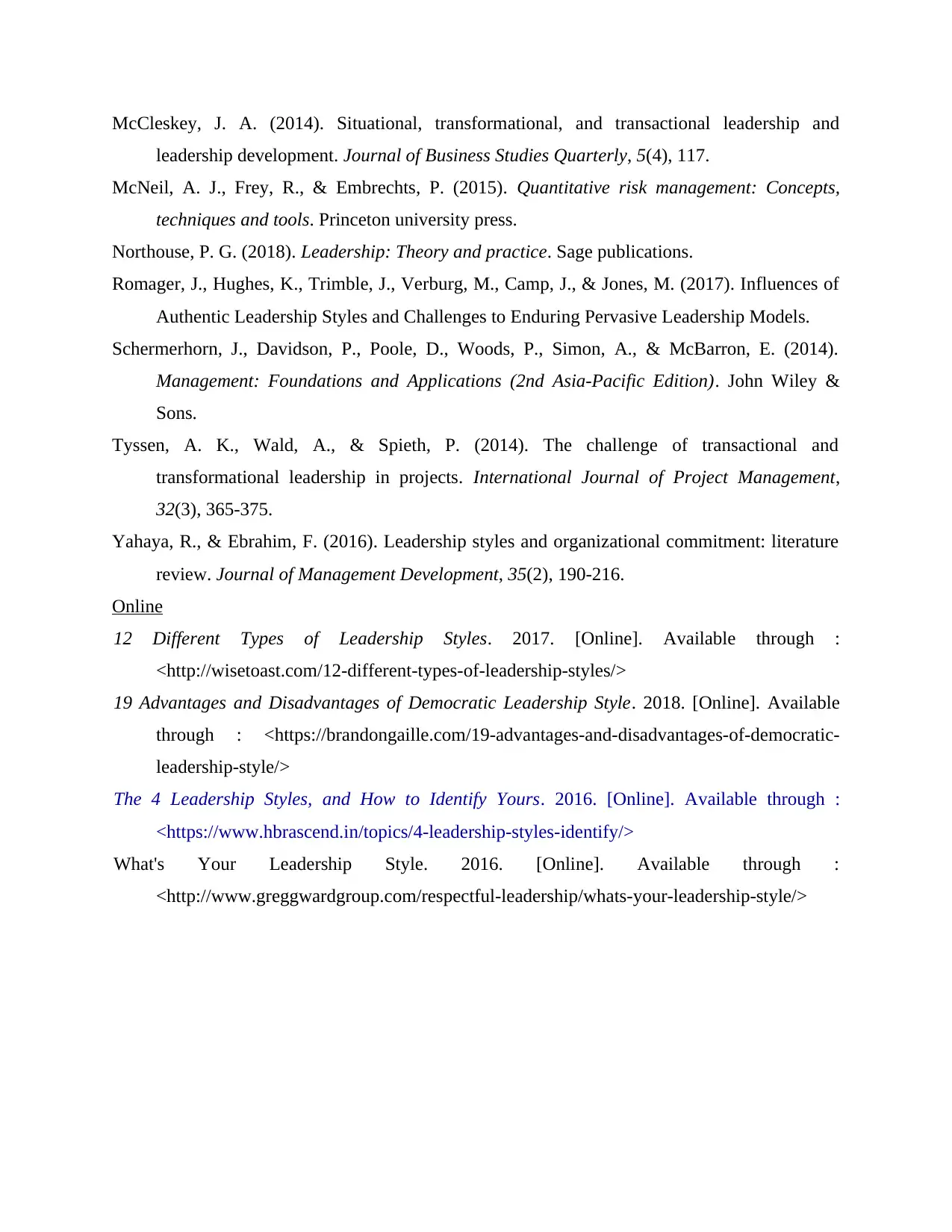
McCleskey, J. A. (2014). Situational, transformational, and transactional leadership and
leadership development. Journal of Business Studies Quarterly, 5(4), 117.
McNeil, A. J., Frey, R., & Embrechts, P. (2015). Quantitative risk management: Concepts,
techniques and tools. Princeton university press.
Northouse, P. G. (2018). Leadership: Theory and practice. Sage publications.
Romager, J., Hughes, K., Trimble, J., Verburg, M., Camp, J., & Jones, M. (2017). Influences of
Authentic Leadership Styles and Challenges to Enduring Pervasive Leadership Models.
Schermerhorn, J., Davidson, P., Poole, D., Woods, P., Simon, A., & McBarron, E. (2014).
Management: Foundations and Applications (2nd Asia-Pacific Edition). John Wiley &
Sons.
Tyssen, A. K., Wald, A., & Spieth, P. (2014). The challenge of transactional and
transformational leadership in projects. International Journal of Project Management,
32(3), 365-375.
Yahaya, R., & Ebrahim, F. (2016). Leadership styles and organizational commitment: literature
review. Journal of Management Development, 35(2), 190-216.
Online
12 Different Types of Leadership Styles. 2017. [Online]. Available through :
<http://wisetoast.com/12-different-types-of-leadership-styles/>
19 Advantages and Disadvantages of Democratic Leadership Style. 2018. [Online]. Available
through : <https://brandongaille.com/19-advantages-and-disadvantages-of-democratic-
leadership-style/>
The 4 Leadership Styles, and How to Identify Yours. 2016. [Online]. Available through :
<https://www.hbrascend.in/topics/4-leadership-styles-identify/>
What's Your Leadership Style. 2016. [Online]. Available through :
<http://www.greggwardgroup.com/respectful-leadership/whats-your-leadership-style/>
leadership development. Journal of Business Studies Quarterly, 5(4), 117.
McNeil, A. J., Frey, R., & Embrechts, P. (2015). Quantitative risk management: Concepts,
techniques and tools. Princeton university press.
Northouse, P. G. (2018). Leadership: Theory and practice. Sage publications.
Romager, J., Hughes, K., Trimble, J., Verburg, M., Camp, J., & Jones, M. (2017). Influences of
Authentic Leadership Styles and Challenges to Enduring Pervasive Leadership Models.
Schermerhorn, J., Davidson, P., Poole, D., Woods, P., Simon, A., & McBarron, E. (2014).
Management: Foundations and Applications (2nd Asia-Pacific Edition). John Wiley &
Sons.
Tyssen, A. K., Wald, A., & Spieth, P. (2014). The challenge of transactional and
transformational leadership in projects. International Journal of Project Management,
32(3), 365-375.
Yahaya, R., & Ebrahim, F. (2016). Leadership styles and organizational commitment: literature
review. Journal of Management Development, 35(2), 190-216.
Online
12 Different Types of Leadership Styles. 2017. [Online]. Available through :
<http://wisetoast.com/12-different-types-of-leadership-styles/>
19 Advantages and Disadvantages of Democratic Leadership Style. 2018. [Online]. Available
through : <https://brandongaille.com/19-advantages-and-disadvantages-of-democratic-
leadership-style/>
The 4 Leadership Styles, and How to Identify Yours. 2016. [Online]. Available through :
<https://www.hbrascend.in/topics/4-leadership-styles-identify/>
What's Your Leadership Style. 2016. [Online]. Available through :
<http://www.greggwardgroup.com/respectful-leadership/whats-your-leadership-style/>
1 out of 16
Your All-in-One AI-Powered Toolkit for Academic Success.
+13062052269
info@desklib.com
Available 24*7 on WhatsApp / Email
![[object Object]](/_next/static/media/star-bottom.7253800d.svg)
Unlock your academic potential
© 2024 | Zucol Services PVT LTD | All rights reserved.



